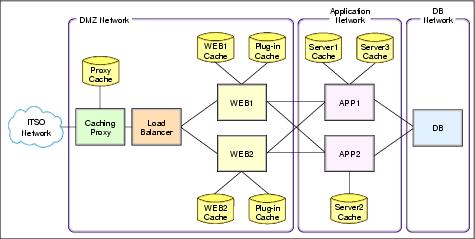Dynamic caching scenarios
The key issue with caching dynamic content is to determine what should be cached, where caching should take place, and how to invalidate cached data.
In a multi-tier e-business environment, the WAS dynamic cache service can be activated at the business logic and/or presentation layer. It can also control external caches on servers, such as WebSphere Caching Proxy or IBM HTTP Server. When external caching is enabled, the cache matches pages with their universal resource identifiers (URIs) and exports matching pages to the external cache. The contents can then be served from the external cache instead of the appserver, which saves resources and improves performance.
To simulate real production systems, we explain the following scenarios:
| At the presentation logic layer (servlet/JSP resulting caching) |
| At the business logic layer (command result caching) |
| Using Web server plug-in with ESI |
| Using IBM HTTP Server with FRCA |
| Using WebSphere Caching Proxy |
We do not focus directly on the caching techniques used by Content Delivery Networks, but we explain the IBM Web server plug-in, which has ESI surrogate capabilities.
When you design the caching solution for your application, you may want to combine different caching techniques. For example you may use a combination of dynamic caching and Web server plug-in caching, or a dynamic caching and WebSphere Caching Proxy combination. This chapter provides you with information that helps you to design your individual caching solution.
We are using the redbook's WAS infrastructure, which is described in detail in Chapter 7, Implementing the sample topology, for our scenarios. We use the WebSphere Performance Benchmark sample application Trade3, because apart from other significant features, Trade3 supports key WebSphere components such as dynamic caching.
As you can see in Figure 14-3 we can use caching services at different tiers of the application infrastructure. Our scenarios explain the appropriate caching techniques for the different tiers.

Figure 14-3 Redbook caching infrastructure
WebSphere is a trademark of the IBM Corporation in the United States, other countries, or both.
IBM is a trademark of the IBM Corporation in the United States, other countries, or both.